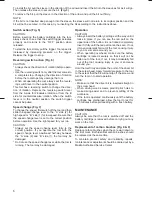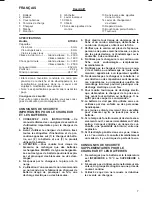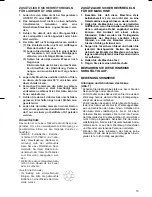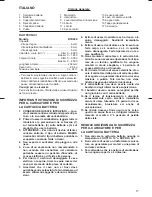
To install the bit, pull the sleeve in the direction of the arrow and insert the bit into the sleeve as far as it will go.
Then release the sleeve to secure the bit. (Fig. 3)
To remove the bit, pull the sleeve in the direction of the arrow and pull the bit out firmly.
NOTE:
If the bit is not inserted deep enough into the sleeve, the sleeve will not return to its original position and the
bit will not be secured. In this case, try re-inserting the bit according to the instructions above.
Switch action (Fig. 5)
CAUTION:
Before inserting the battery cartridge into the tool,
always check to see that the switch trigger actuates
properly and returns to the ‘‘OFF’’ position when
released.
To start the tool, simply pull the trigger. Tool speed is
increased by increasing pressure on the trigger.
Release the trigger to stop.
Reversing switch action (Fig. 6)
CAUTION:
• Always check the direction of rotation before opera-
tion.
• Use the reversing switch only after the tool comes to
a complete stop. Changing the direction of rotation
before the tool stops may damage the tool.
• When not operating the tool, always set the revers-
ing switch lever to the neutral position.
This tool has a reversing switch to change the direc-
tion of rotation. Depress the reversing switch lever
from the A side for clockwise rotation or from the B
side for counterclockwise rotation. When the switch
lever is in the neutral position, the switch trigger
cannot be pulled.
Speed change (Fig. 7)
To change the speed, first switch off the tool and then
slide the speed change lever to the ‘‘A’’ side (2) for
high speed or ‘‘B’’ side (1) for low speed. Be sure that
the speed change lever is set to the correct position
before operation. Use the right speed for your job.
CAUTION:
• Always set the speed change lever fully to the
correct position. If you operate the tool with the
speed change lever positioned half-way between
the ‘‘A’’ side (2) and ‘‘B’’ side (1), the tool may be
damaged.
• Do not use the speed change lever while the tool is
running. The tool may be damaged.
Operation
CAUTION:
• Always insert the battery cartridge all the way until it
locks in place. If you can see the red part on the
upper side of the button, it is not locked completely.
Insert it fully until the red part cannot be seen. If not,
it may accidentally fall out of the tool, causing injury
to you or someone around you.
• When operating overhead, make sure the battery
cartridge is locked securely so that it will not be
fallen out of the tool. If not, it may accidentally fall
out of the tool, causing injury to you or someone
around you.
Hold the tool firmly and place the point of the driver bit
in the screw head. Apply forward pressure to the tool
to the extent that the bit will not slip off the screw and
turn the tool on to start operation.
NOTE:
• Make sure that the driver bit is inserted straight in
the screw head.
• When driving wood screws, predrill pilot holes to
make driving easier and to prevent splitting of the
workpiece.
• If the tool is operated continuously until the battery
cartridge has discharged, allow the tool to rest for
15 minutes before proceeding with a fresh battery.
MAINTENANCE
CAUTION:
Always be sure that the tool is switched off and the
battery cartridge is removed before carrying out any
work on the tool.
Replacement of carbon brushes (Fig. 8 & 9)
Replace carbon brushes when they are worn down to
the limit mark. Both identical carbon brushes should
be replaced at the same time.
To maintain product safety and reliability, repairs,
maintenance or adjustment should be carried out by a
Makita Authorized Service Center.
6
BTD200 (E) (’100. 10. 27)







































